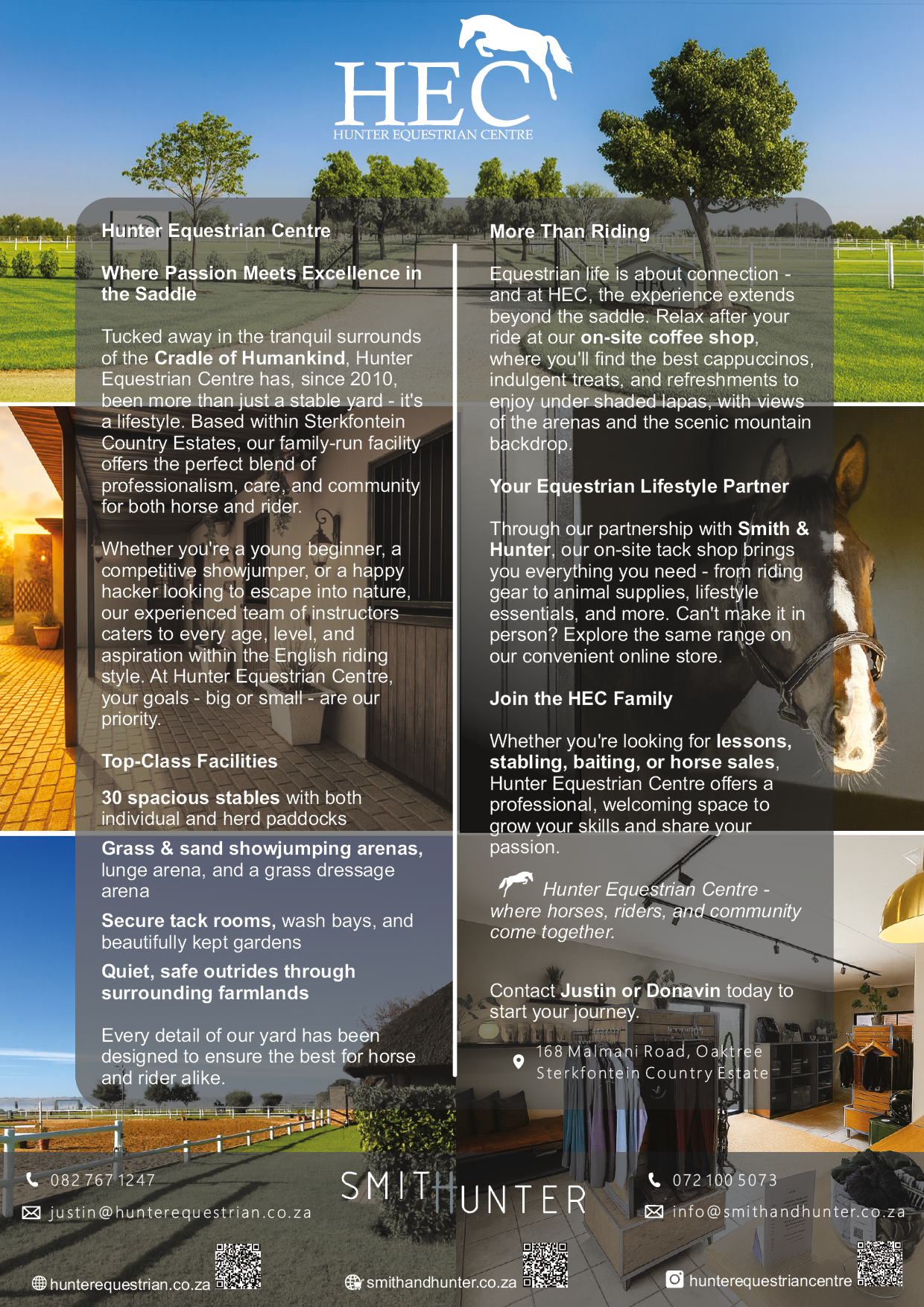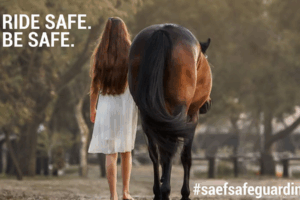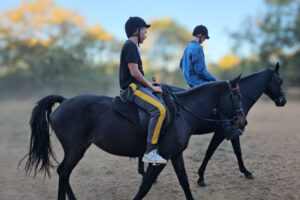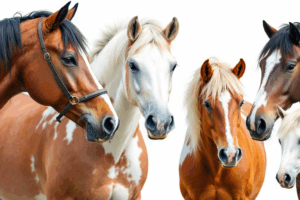From gymkhana roots to national glory, this is South Africa’s sport of speed and precision
Photos courtesy of Denford Studios
Written by Charlene Carroll
The air is thick with dust and excitement. Hooves thunder down the arena, kicking up red earth as riders lean low into their turns, hats tight against the wind. The crowd gasps as a barrel wobbles but doesn’t fall. You can hear a pin drop, suddenly, from somewhere a voice hollers in encouragement. For a moment, you could swear you were at a rodeo in Oklahoma or watching barrel racers tear up an arena in Texas.
But this isn’t the American West. This is home. This is the South African Western Mounted Games (SAWMGA), widely touted as one of the country’s most dynamic and fast-growing equestrian disciplines. This is where the South African cowboy spirit runs deep, and the thrill of speed and precision meets pure, homegrown heart. It’s a sport that trades lassos for stopwatches, where teamwork replaces showmanship, and where ordinary riders and horses achieve extraordinary feats.
Born from the dust, driven by rhythm, and defined by trust, Western Mounted Games is as much a celebration of horsemanship as it is of grit. Across the country, from Limpopo’s red sands to the Western Cape’s emerald paddocks, South Africans are saddling up for one of the most exhilarating disciplines ever to hit the local equestrian scene.
From Pony Club Games to a national phenomenon
The story of the modern version of the Western Mounted Games began in the UK in 1957 when Prince Philip proposed a competition for children without expensive ponies. Those early British Pony Club Games tested teamwork, accuracy and control, soon spreading across the globe and inspiring variations suited to local riding cultures.
In time, the sport evolved into Western Mounted Games, combining the gymkhana spirit of speed-pattern riding with the accuracy of Western-style horsemanship. South Africa formalised its version through SAWMGA, drawing its foundation from the California Gymkhana Association’s rulebook and adapting it for South African arenas, horses and riders.
While the British games were rooted in Pony Club teamwork and playful competition, the American version grew out of cowboy culture. In the US, Western Gymkhana events evolved from rodeo arenas and ranch life, where horses were trained to turn sharply, stop hard, and respond instantly to their riders. It was this cowboy-infused format that South Africa embraced, blending Western energy with local horsemanship to create a uniquely home-grown version of the sport.
Today SAWMGA operates under the South African Equestrian Federation (SAEF) and is officially recognised by SASCOC. The association now spans all nine provinces, building a national community united by skill, speed and sportsmanship. What began as a fringe activity has become one of South Africa’s most exciting and inclusive equestrian pursuits.
What it’s all about
Western Mounted Games celebrate accuracy, balance and the ability to think and react at lightning speed. Riders complete timed patterns that demand near-telepathic communication with their horses, as both set about weaving through poles, snatching flags, pivoting around barrels and stopping on a mark no wider than a hoofprint.
In South Africa, the discipline includes the 13 official American Gymkhana events: Barrel Racing, Keyhole, Hurry Scurry, Pole Bending (Poles 1 and 2), Quadrangle, Bi-Rangle, Single Stake, Figure 8 Flags, Figure 8 Stake, Speed Ball, Big T and Speed Barrels. A typical qualifier show features five events, while the National Championships include twelve of the thirteen across three days of competition.
Popular races include:
- Barrel Racing – Three barrels, one cloverleaf pattern, and a whole lot of horsepower. Riders gallop full tilt, turning tight and fast enough to make dust clouds swirl. It’s the event that captures the true rodeo spirit and is one of the biggest crowd favourites.
- Pole Bending – A test of precision and timing, where riders weave through a row of poles with whip-like rhythm and perfect lead changes. One wrong stride can cost precious seconds, making this as much a mental game as a physical one.
- Figure 8 Stake and Speedball – Two of the most technically demanding events, pushing both horse and rider to their limits. The Figure 8 Stake requires split-second decision-making around sharp turns, while Speedball demands steady hands and balance under pressure.
- Rescue Race and Ribbon Race – The ultimate team tests. The Rescue Race calls for courage and trust as one rider sweeps up a teammate at full gallop, while the Ribbon Race celebrates pure coordination — two riders side by side, gripping a ribbon between them as they race for the finish. It’s partnership, trust, and chaos all in one exhilarating blur.
In all disciplines, each run is timed to the thousandth of a second, and penalties for breaking the pattern or dislodging obstacles are added to the final score. The fastest clean run wins, ensuring fair, transparent judging based solely on performance.
Riders compete in divisions ranging from Lead Rein and Level 0 to Level 4, with levels determined by a detailed Rating Matrix that tracks average times across the season. This system rewards both speed and consistency, recognising the progress of every horse-rider combination rather than raw pace alone.
“The beauty of Western Mounted Games is that it’s a true partnership,” says SAWMGA President, Hennie Mey. “It’s about communication, timing, and trust. You don’t need the most expensive horse, you just need the best teamwork.”
The horses behind the speed
Unlike some equestrian sports that demand specialist breeding, Western Mounted Games welcomes every type of horse and pony. What counts is temperament, agility and willingness to learn. From Thoroughbreds and Arabians to South African Boerperds and mixed-breed ponies, the sport thrives on diversity.
A good games horse combines the speed of a racehorse with the turning ability of a cutting horse and the responsiveness of a stock horse. Training focuses on transitions, lead changes and balance – skills that benefit every discipline. Riders from showjumping, eventing, polo-cross and endurance often find that their mounts adapt naturally to the patterns and pace of mounted games.
The result is a discipline that strengthens the partnership between horse and rider, developing coordination, rhythm and trust that carry through to any other arena. These are not farm ponies; they are well-schooled, balanced, and confident athletes.
South Africa’s proud milestones
The sport’s rise has been meteoric. In 2024, history was made when SASCOC awarded the first-ever Protea Colours in Western Mounted Games, which was a defining moment for the discipline and a sign of its growing stature. The national team of Lezanne Jacobs, LJ van der Nest, Clayton Wiggill, Mia Fourie and Wilru de Vries represented South Africa in the Tri-Nations Tournament against Botswana and Zimbabwe in Parys, Free State.
A year later, in 2025, SASCOC again awarded Protea Colours in Western Mounted Games. The Protea Team, made up of Elaine Fourie, LJ van der Nest, Dries Ellis, Lorenco Crous and Tana Martini, once again flew the flag high in the Cup of Nations, facing competitors from Zimbabwe, Botswana and the UK (also in Parys). Their victory reinforced South Africa’s reputation as a powerhouse in this rapidly expanding sport.
These milestones are more than just wins; they mark the arrival of Western Mounted Games as a respected national discipline and a springboard to future international participation.
Rising stars and grassroots growth
From small towns to major centres, arenas across the country are buzzing with new energy. The sport’s accessibility has opened doors for riders of all ages and backgrounds. You don’t need a string of expensive horses or years of show experience to start – just enthusiasm, commitment and a love for fast, technical riding.
Eight-year-old Liam Ross from Kidd’s Beach Primary made headlines when he qualified to represent the Eastern Cape at Nationals, riding a horse he had met only the day before. His story captures what SAWMGA stands for: courage, adaptability and the confidence that grows from trying something new.
Through SANESA, schools are introducing students to the sport, creating pathways for young riders to progress from local qualifiers to national teams. Each new season brings an influx of fresh talent, young and old, proving that Western Mounted Games is as much about fun and friendship as it is about medals.
The heart of the sport
Beyond the stopwatch lies the heart of SAWMGA. A community bound by camaraderie and shared passion. Riders cheer for one another, lend tack, and celebrate every clean run, no matter the placing. Events often feel more like festivals than competitions, with laughter, dust and the rhythmic beat of hooves filling the air.
The association also places strong emphasis on fair play, welfare, horsemanship, and sportsmanship, and upholds the standards set by the SAEF and SASCOC. Every competitor learns not only to ride faster and more accurately, but also to respect their horse, their fellow riders and the spirit of the game.
Each gathering is a reminder that this is not just about trophies. It’s about the connection between horse and human, and among those who share the same pulse-quickening love of the sport.
What’s next for SAWMGA
With national recognition now secured, SAWMGA’s ambitions continue to grow. The association aims to expand provincial circuits, refine judging and training standards, and build clear pathways to international competition. Its long-term vision is to see South Africa competing alongside nations such as the US, UK, Europe, Australasia and the rest of Africa in global Mounted Games championships.
The message is simple: Western Mounted Games is for everyone. Any horse can compete, and any rider with determination and balance can excel. The sport rewards dedication, builds confidence, and strengthens the bond at the core of all good riding… trust.
As the dust settles after each run, one thing is certain: the Western Mounted Games arena will always be a place where riders push their limits, horses show their hearts, and the joy of speed brings people together.
Across South Africa, from the Karoo plains to coastal arenas, Western Mounted Games are blazing their own trail, combining Western energy with African soul in a sport that’s as thrilling as it is homegrown.
Fast Facts:
Founded: SAWMGA was established in 2011
Affiliation: South African Equestrian Federation (SAEF)
Events: 13 individual + 4 team events
Competition Levels: Lead rein, Levels 0–4
2024 Highlight: First Protea Colours awarded
2025 Highlight: Second time Protea Colours awarded
Website: www.sawmga.co.za

















